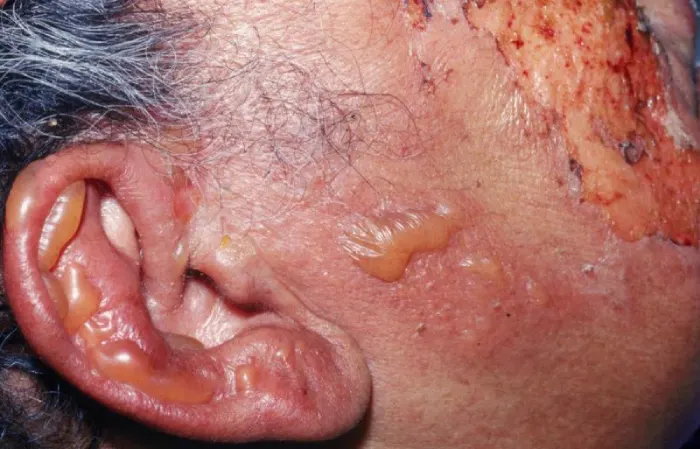Published on

Differential Diagnoses
- Allergic contact dermatitis
- Ramsay-Hunt syndrome
- Bullous fixed drug eruption
- Varicella infection
- Bell palsy
Diagnosis
Ramsay-Hunt syndrome
Learnings
Herpes zoster oticus is a viral infection characterized by herpetic eruption of the auricula and external ear canal. When it is associated with facial palsy, it is known as Ramsay-Hunt syndrome. The annual incidence of Ramsay-Hunt syndrome in the United States is about 5 cases per 100,000 persons, with a significantly increased incidence in those older than 60 years. Ramsay-Hunt syndrome rarely occurs in children. The syndrome is caused by the reactivation of latent varicella-zoster virus (VZV) in the geniculate ganglion (the sensory ganglion of the facial nerve), which affects the seventh and eighth cranial nerves. Reactivation may be triggered by immunosuppression, certain medications, other infections, or different forms of physical or emotional stress.
Ramsay-Hunt syndrome generally starts with a 1- to 3-day prodrome of otalgia and ipsilateral facial paralysis and is followed by development of herpetic vesicles on the face just anterior to the tragus and various parts of the ear, including the auricle, external ear canal, and tympanic membrane. Vesicles may also appear in the mouth and anterior two-thirds of the tongue. Evolution of disease may differ between age groups; in children, the vesicles may appear several days after the facial paralysis. Over the course of a week, the vesicles become pustules, and then ulcerate to form crusts. The lesions heal within weeks and may leave scars. Other symptoms can include tinnitus, hearing loss, vertigo, hyperacusis, nystagmus, nausea, vomiting, taste impairment, lesions of the oral mucosa, dry mouth, and dry eyes. Cerebrovascular accidents have been associated with VZV.
Diagnosis is primarily clinical and is based on a combination of facial palsy, otalgia, and vesicles on the pinna or oral mucosa. Treatment is empiric and involves the use of high-dose corticosteroids and antiviral therapy. Ramsay-Hunt syndrome is less common than Bell palsy (idiopathic facial palsy), tends to cause more severe paralysis, and has a worse prognosis for facial nerve recovery (especially in children). Only 10% of patients with complete facial paralysis are totally cured. Prognosis for associated hearing loss is very good, with only about 5% of patients having residual impairment.
What to Look For
Examination will show grouped vesicles or small bullae on an erythematous base ipsilaterally involving the auricle, external ear canal, and tympanic membrane, as well as the mouth and anterior two-thirds of the tongue, with concomitant ipsilateral facial palsy.
Early on, the lesions may appear as grouped urticarial papules. Vesicles may be confluent, sparse, or discrete. Commonly, vesicles become hemorrhagic, umbilicated, or pustular after several days. The lesions typically crust over and resolve after a 7- to 14-day course. Scarring is common.
The otalgic symptoms associated with facial paralysis are severe ear pain in the affected ear, hearing loss, tinnitus, and hyperacusis. Other associated symptoms are vertigo and dysgeusia (taste dysfunction) .Nausea and vomiting may also be present, as may regional adenopathy. Some patients may experience acute segmental neuralgia without ever developing a cutaneous eruption; this is known as zoster sine herpete.
Treatment
The treatment of Ramsay Hunt syndrome involves antiviral medications like acyclovir or famciclovir, as well as corticosteroids like prednisone, ideally within three days of symptom onset. Some facial paralysis and hearing loss may become permanent in some people.
Acknowledgment: Image courtesy of Logical Images, Inc. (www.VisualDx.com/JUCM)
